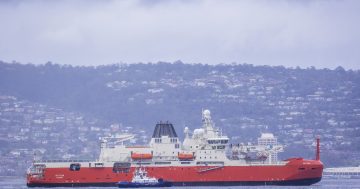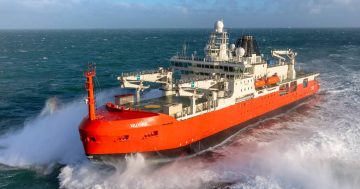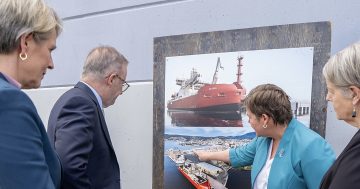 Scientists from the Australian Antarctic Division (AAD) on board the new Antarctic icebreaker, RSV Nuyina, have discovered a giant under-ice canyon at the front of the Vanderford Glacier in East Antarctica.
Scientists from the Australian Antarctic Division (AAD) on board the new Antarctic icebreaker, RSV Nuyina, have discovered a giant under-ice canyon at the front of the Vanderford Glacier in East Antarctica.
Announcing the discovery, the Division said the previously unknown canyon was discovered by AAD Acousticians Floyd Howard (pictured left), Jill Brouwer (centre) and Alison Herbert (right), was more than 2,200 metres deep, 2,000 metres wide and at least 55 kilometres long.
Mr Howard said that although scientists had been visiting the region for decades previously, they did not have the capability to do the type of detailed mapping which led to the discovery.
“As a result, current navigational charts of this area are based on fairly limited surveys,” Mr Howard said.
“Our work has shown that the seafloor is deeper and more complex than we thought,” he said.
“The multibeam echo-sounder sends out pings of sound in a fan shape beneath the ship and ‘listens’ to the returning echoes to build a picture of the seafloor.”
Mr Howard said the sideways projection of sound also allowed the team to map the canyon underneath the glacier for up to three and a half kilometres from the front.
AAD’s Voyage Leader, Lloyd Symons said it was not unusual to see interesting features in front of glaciers, but he was not expecting the discovery of a canyon this deep.
“It is truly mind boggling to look northward to the nearby Browning Peninsula and know that there is 2,200 metres of water underneath the keel,” Mr Symons said.
“It will be really interesting to see how we can use Nuyina’s acoustic capabilities to improve our understanding of the seafloor bathymetry around our other stations in the future, particularly the approach to Mawson, which has a deep, narrow channel surrounded by pinnacles of rock,” he said.
Mr Symons said data from this and other mapping efforts on board Nuyina would feed into global efforts to map the world’s oceans by 2030.
Minister for the Environment, Sussan Ley said the RSV Nuyina was expected to return to Hobart by 30 January to prepare for a second voyage this Antarctic season to Davis and Macquarie Island research stations.





